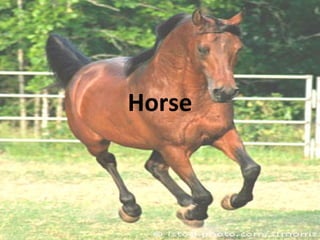
9115
- 1. Horse
- 2. Classification Kingdom: Animalia Phylum: Chordata Class: Mammalia The Horse is a single-hooved (ungulate) mammal belonging to the Subclass: Theria taxonomic family Equidae. The horse has evolved over the past Infraclass: Eutheria 45 to 55 million years from a small multi-toed creature into the large, single-toed animal of today. Horses in the subspecies Order: Perissodactyla caballus are domesticated, although some domesticated Family: Equidae populations live in the wild as feral horses. These feral Genus: Equus populations are not true wild horses, as this term is used to describe horses that have never been domesticated, such as the Species: E. ferus endangered Przewalski’s Horse, a separate subspecies, and the Subspecies: E. f. caballus only remaining true wild horse. The horses' anatomy enables them to make use of speed to escape predators and they have a well- developed sense of balance and a strong fight or flight instinct. Related to this need to flee from predators in the wild is an unusual trait: horses are able to sleep both standing up and lying down. gestation lasts for approximately 335–340 days and usually results in one foal, twins are rare in horses. Horses are a precocial species, and foals are capable of standing and running within a short time following birth. Horses are herbivores with a digestive system adapted to a forage diet of grasses and other plant material, consumed steadily throughout the day. Therefore they have a relatively small stomach but very long intestines to facilitate a steady flow of nutrients. http://en.wikipedia.org/wiki/Horse
- 4. Sesamoid bones 1. 1. Metatarsal base 2. Metatarsal body 3. Proximal phalanx 2. 4. Middle phalanx 5.Extensor process 6. Distal phalanx 7. Plantar process 8. Proximal sesamoid bones 3. 4. 5. 6. 8. 7.
- 7. 1. 2. 1.Metatarsal base 2. Metatarsal body 3. Metatarsal head 4. Proximal sesamoid bones 5. Triangular rough area 3. 6. Flexor tuberosity 7. Distal sesamoid bone 8. Parietal groove 9. Palmar process 4. 5. 6. 7. 8. 9.
- 11. 1. 2. 3. 4. 1.Distal phalanx 2. Distal (navicular) 5. sesamoid bone 3. Middle phalanx 4. Proximal phalanx 5. Proximal sesamoid bones
